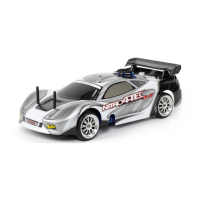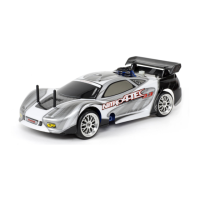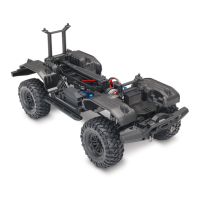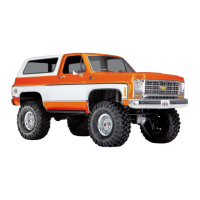
Do you have a question about the Traxxas 4 TEC 2.0 AWD CHASSIS BL-2S BRUSHLESS POWER SYSTEM and is the answer not in the manual?
| Power System | Brushless |
|---|---|
| Battery Type | LiPo or NiMH |
| Chassis | 4-Tec 2.0 |
| Scale | 1/10 |
| Skill Level | 1 |
| Drive System | 4WD |
| ESC | VXL-3s |
| Radio System | TQi 2.4GHz Radio System |
Information about Traxxas support options and contact methods.
Overview of the quick start path for model setup and operation.
Instructions on how to register your product online.
Regulatory compliance information for the device according to FCC and IC rules.
Specifications for the TQ radio system and High-Current Connector.
Contact details and information for Traxxas technical support and service.
Traxxas company contact details and physical address.
Copyright and trademark information for Traxxas products and manuals.
Key points for safe operation, including warnings about public roads and crowds.
Information about the skill level required for operating the model.
Precautions for the ESC to prevent damage and ensure safety.
Guidance on recycling Traxxas iD NiMH batteries.
Critical warnings about LiPo battery fire hazards and necessary precautions.
Specific warnings and user responsibilities for LiPo battery usage.
Crucial precautions for charging and handling all battery types safely.
Guidelines for safe charging and discharging environments for all battery types.
Warnings against disassembling batteries and handling potential leaks.
Procedure for handling hot batteries during the charging process.
Important steps for disconnecting batteries and chargers when not in use.
Lists and images of tools supplied with the model.
Lists essential equipment needed to operate and maintain the model.
Lists optional but recommended tools and supplies for an RC toolbox.
First step: read safety precautions on pages 4-6.
Second step: charge the battery pack as detailed on page 13.
Third step: install batteries in the transmitter as shown on page 13.
Fourth step: install the battery pack into the model on page 14.
Fifth step: install the receiver antenna properly on page 14.
Sixth step: turn on the radio system following page 15.
Seventh step: check servo operation as described on page 16.
Eighth step: range test the radio system on page 16.
Ninth step: apply decals to detail the model as shown on page 10.
Tenth step: drive the model, following tips on page 20.
Eleventh step: perform maintenance on the model as per page 28.
Instructions on how to apply decals to the model.
Introduction to the TQ 2.4GHz transmitter and system terms.
Definitions of radio and power system terms used in the manual.
Definitions of electrical terms (resistance, voltage) and motor components.
Definitions for servo, transmitter, trim, ESC thermal shutdown, and radio system types.
Explanation of the 2.4GHz spread spectrum technology used.
Critical precautions for the radio system antenna and wiring.
Diagram illustrating the wiring connections for the BL-2s system.
Identification of controls and components on the transmitter and receiver.
Diagram showing the overall wiring of the model's electronic components.
Detailed view and labels for the BL-2s electronic speed control.
Step-by-step instructions for installing batteries in the transmitter.
Guide to choosing compatible battery packs for the model.
Advice on using appropriate batteries for the transmitter.
Guidance on selecting the correct charger for different battery types.
Explanation of Traxxas Battery ID technology for optimized charging.
Instructions for correctly installing the battery pack into the model.
Description of the Traxxas iD High-Current Connector's advantages.
Instructions for properly installing the receiver antenna for maximum range.
Diagram and labels for the radio system controls.
Essential rules for operating the radio system safely and correctly.
How to make basic adjustments like steering trim and channel reversing.
Explanation of how to adjust the steering trim.
Instructions for reversing steering and throttle channels.
How to use the throttle trigger for forward, brake, and reverse.
Detailed steps to reverse the throttle channel.
How to check radio system operation and make initial adjustments.
Procedure for testing the radio system's range before driving.
How model speed affects radio range and visibility.
Steps for binding the transmitter and receiver.
Explanation of the Failsafe function and its activation.
Chart of transmitter LED status indicators and their meanings.
Chart of receiver LED status indicators and their meanings.
How to set up and verify Low-Voltage Detection for LiPo and NiMH batteries.
Critical warning about using LiPo batteries with disabled Low-Voltage Detection.
Steps to check if Low-Voltage Detection is active or disabled.
Procedure to activate Low-Voltage Detection for LiPo batteries.
Procedure to disable Low-Voltage Detection for NiMH batteries.
How to reset transmitter settings to factory defaults before ESC programming.
Step-by-step guide to calibrate the ESC and transmitter.
How to operate the speed control and test its functions.
Explanation of how to select different driving profiles (Sport, Race, Training).
Procedure to select Sport Mode (100% Forward, Brakes, Reverse).
Procedure to select Race Mode (100% Forward, Brakes, No Reverse).
Procedure to select Training Mode (50% Forward, Brakes, Reverse).
Quick tips for switching between Sport and Training Modes.
Explanation of different LED blink patterns and what they indicate.
General advice and precautions for driving the model safely.
Importance of cooling the model's motor and ESC between runs.
Warning about operating with low batteries and signs of weakness.
Prohibitions on where and when to drive the model.
What to do if the model becomes stuck against an object.
Reminder about radio interference and maintaining safety margins.
Advice on driving habits and maintaining model longevity.
Importance of regularly checking hardware tightness.
Factors affecting model run time, including battery capacity.
Tips to extend the model's run time.
Information and precautions for driving the model in wet conditions.
Warning about responsibilities when running the model in wet conditions.
Information on battery compatibility for wet environments.
Warning that the transmitter is not water resistant.
Safety warning regarding operating the model during thunderstorms.
Warnings about salt water, brackish water, and contamination.
Specific precautions for the motor when running in wet conditions.
Preparations required before running the model in wet conditions.
Procedures for cleaning and maintaining the model after wet running.
Instructions for maintaining the receiver box's watertight seal.
Procedures for removing and installing the receiver and radio gear.
Steps to remove the receiver from the box.
Steps for installing the receiver back into the box.
Recommendation for optimal receiver installation orientation.
How to set the gear mesh for optimal drivetrain performance.
How shock mounting affects suspension and ride height.
Adjusting shocks for optimal handling and damping.
Procedure to re-center the steering servo.
Chart showing acceptable gear combinations and their implications.
Advice on gearing for different motor types and driving styles.
Recommendation for smaller pinions in stop-and-go driving.
How to tune differential performance with oil viscosity.
Step-by-step guide to removing the front differential.
Step-by-step guide to removing the rear differential.
Instructions for draining and refilling differential fluid.
How to adjust body mounts for different body styles.
Modifying steering blocks for increased steering angle.
How to adjust the wheelbase for optimal body fit.
Options for mounting rear camber links for body compatibility.
How to adjust suspension droop for improved stability.
Safety reminder to wear eye protection when using compressed air or cleaners.
Routine inspection checklist for damage and wear on the vehicle.
Additional maintenance tasks for chassis, suspension, steering, and shocks.
Guidelines for storing the model and its batteries.
Maintenance for shock absorbers, including oil levels and seals.











